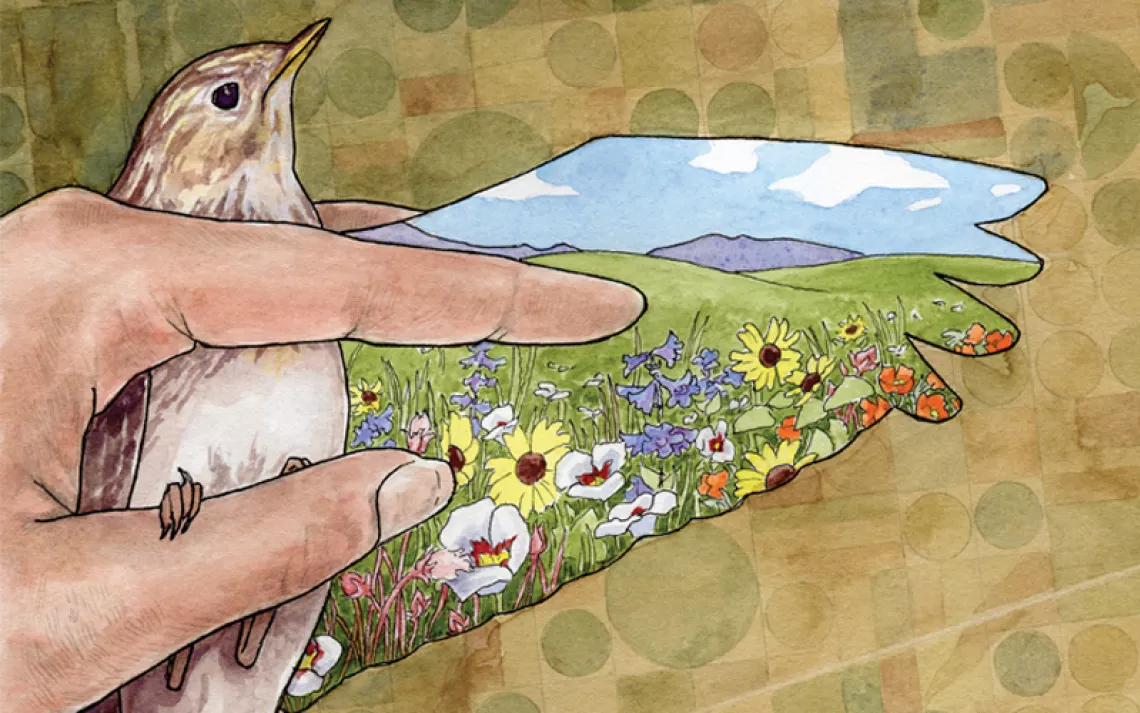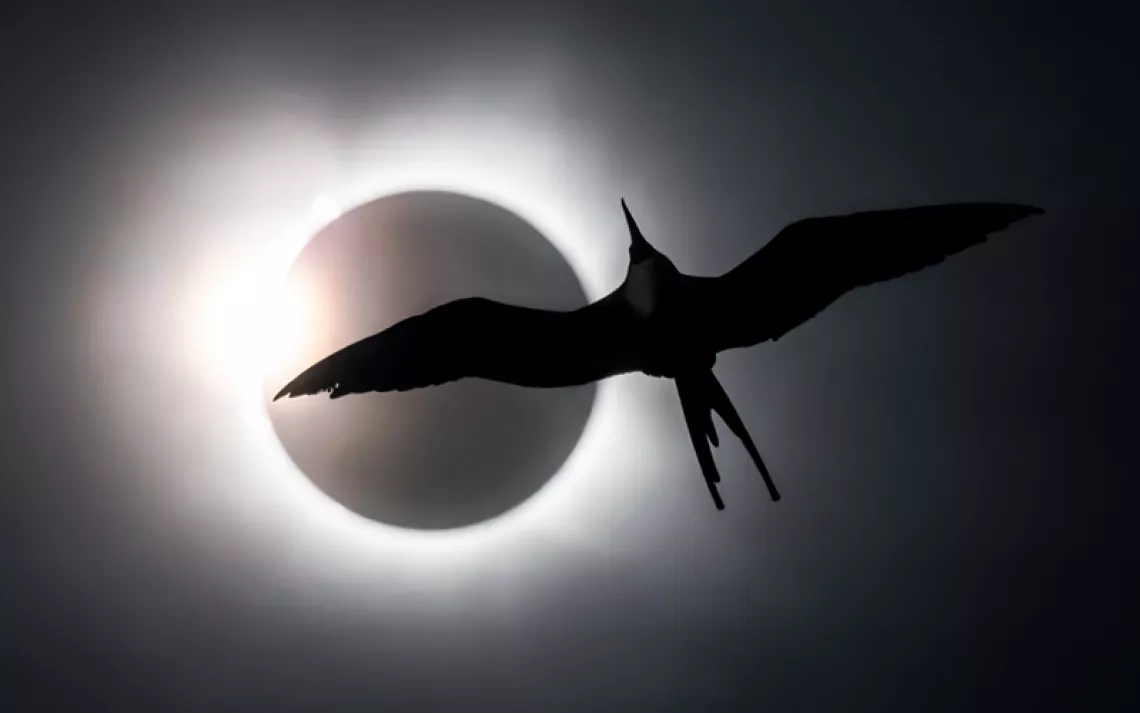I Was a Newbie Bird Counter
eBird turns novices into citizen scientists, and bird sightings into biodiversity data

Photographs courtesy of Alvaro Jaramillo
Every year in May, Christopher Wood, assistant director of information science at the Cornell Lab of Ornithology, is occupied by one question: “If everybody around the world were to all go looking for birds on the same day, how many species could we find?”
Today, May 4, is that day. Wood is searching for avian life in the marshes of Alabama. Meanwhile, I peer through binoculars into the mists of Edgewood Park in Redwood City, California, with avid birder Whitney Mortimer. Seventeen miles west, Alvaro Jaramillo has left Pillar Point Harbor in Half Moon Bay, hoping to see birds only found at sea.

Wood, Mortimer, Jaramillo, and I are all participating in Global Big Day, a 24-hour birdwatching marathon designed to get as many people as possible outside, recording the birds they see. We are all using a mobile app called eBird, managed by the Cornell Lab of Ornithology, to record our sightings.
On any day of the year, eBird functions as the largest biodiversity-related citizen science project in the world. Users input more than 100 million bird sightings each year, while the app automatically collects data like the date, distance, and time the birder was out for.
With this information, the team at Cornell is able to gather information about things like bird distribution, population, and habitat use. “We're interested in understanding what's happening with a biological system,” Wood says. “And in order to do that, we also need to understand what's happening with the birdwatcher as part of the observation process.”

Birding data is valuable because birds are one of the most accessible manifestations of biodiversity in the world. “Flowers are ephemeral, butterflies are hard to identify, and mammals are well hidden,” Wood says. “But birds—they are singing, they are pretty, they are out in the open in almost all habitats. While they're not going to tell us about what's happening with every indicator of biodiversity, they give us an overall idea about what's happening in natural systems.”
For that reason, while birders often focus exclusively on sighting rare and elusive species, eBird asks users to enter all the birds they see, whether house sparrows or starlings, into the app. With a complete list like this, eBird can see a full range of species that were present at a particular place and point in time, and anyone can access this information to combine it with other datasets (like weather or satellite imagery) that can point to larger changes happening in the ecosystem.
However, data collected by volunteers (also known as citizen scientists) can be inconsistent and sometimes just wrong. If I had gone birdwatching in Edgewood Park without someone as experienced as Mortimer, I would quite possibly have misidentified, miscounted, or missed species entirely. Mortimer herself was reluctant to add data to eBird when she first started using the app five years ago, because she was afraid of making mistakes. “I thought I would single-handedly ruin science, which is ridiculous,” she says.
Cornell tries to help novice birders like me get up to speed by preloading profiles into eBird of birds likely to be seen at a particular location, and with Merlin, an app that helps to identify birds. eBird also double-checks unlikely entries by using experts to verify sightings.
But eBird and Cornell also work to keep experienced birders using the app, and they understand they can only do this by giving birders something they want. “Birders love checklists,” Jaramillo says. “They like to know how many birds they saw any given day, and some definitely like the element of competition. Now we suddenly have a birding culture that has shifted entirely based on this application.”
Mortimer also thinks that eBird has changed the culture around birding. For many people, she says, it is the idea that the count they record will become an important part of conservation efforts over the years that makes it even more fun. “Suddenly you're part of a global community that's collecting information for the benefit of the birds that everybody loves,” she says.

Since all the observations posted to eBird are open and available, people are free to play with the data in search of the answers to new scientific questions. What is the distribution of sarus cranes in a region of India? How, when, and why are tiger sharks eating land-dwelling birds? What are the effects of urbanization on native bird species in cities? In the last five years, there have been over 200 peer-reviewed publications that have made use of eBird data. “There's nothing else on Earth, other than weather data itself, which we are gathering that is worldwide in aspect, daily in nature, and widespread enough that we could track trends with,” Jaramillo says.
The data has real-world applications for conservation as well. “eBird is really useful to make targeted and precision conservation efforts that need to happen at specific locations at specific times of the year,” Wood says. California’s Central Valley is one of the most industrialized agricultural systems in the world but remains critical habitat for birds migrating through California. The Nature Conservancy wanted to understand exactly when birds were moving through the Central Valley and where they may be. The eBird team combined bird sightings with another data set that showed when and where water was available.
When these critical areas in the valley were identified, Nature Conservancy paid rice farmers in those regions to flood their fields when they weren’t growing rice—providing habitat for shorebirds and ducks at a fraction of the cost it would have taken to buy prime farmland and turn it into year-round habitat.

By the end of Big Day, eBirders gathered more than 1.85 million bird sightings on the platform—over 32,500 people in 171 countries observed in a day—6,816 different species.
Twenty miles from the Pacific shore, in waters over 1,000 feet deep, Jaramillo serendipitously runs into a migrant corridor of Sabine’s gulls, pomarine jaegers, and red-necked phalaropes, all headed for the Arctic.
In the marshes of Mobile, Alabama, Wood is surrounded by brown pelicans, short-billed dowitchers, and black skimmers. More than 2 billion migratory birds depend on the Gulf Coast states to provide habitat after their journey across the Gulf of Mexico as they return from wintering in Central and South America.
In Edgewood Park, hares, deer, and a mole join us on the path. Mortimer rattles off the different bird songs she hears as we walk—there’s an acorn woodpecker and here’s a Pacific-slope flycatcher—and describes the birdsong mnemonics she uses to help correctly identify different species.
We watch a young spotted towhee hiding in the bushes and follow a dark-eyed junco to its nest in the park restroom. This world seen through my borrowed binoculars reminds me of birdwatching trips in India when I was in school. It was so long ago that I can only identify the crows now.
Two hours and 1.5 miles after I began counting birds with Mortimer, I am back at the parking lot in Edgewood Park. Chestnut-backed chickadees, dark-eyed juncos, and Anna’s hummingbirds are still flitting around in my mind as the sun finally burns off the mist.
 The Magazine of The Sierra Club
The Magazine of The Sierra Club



